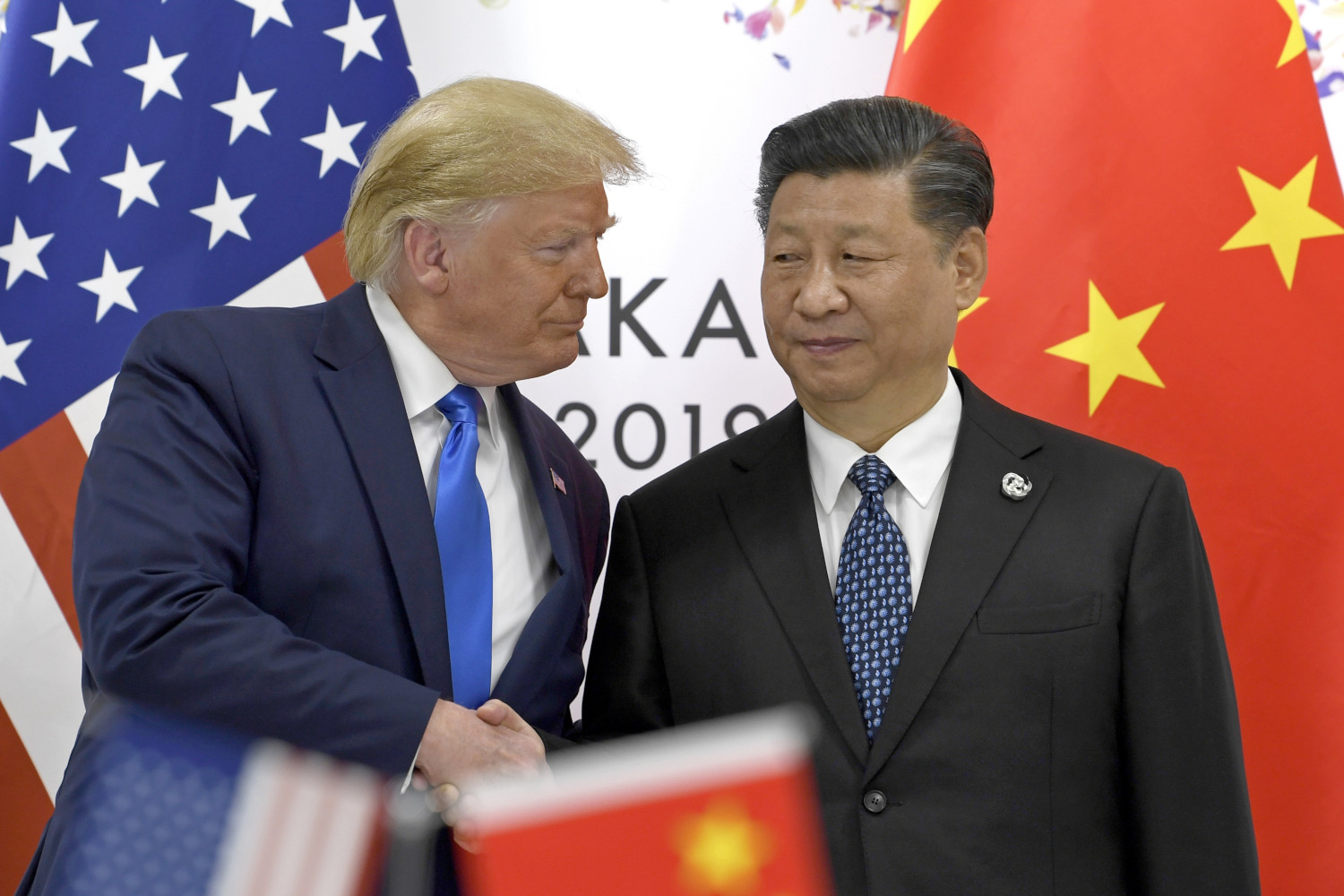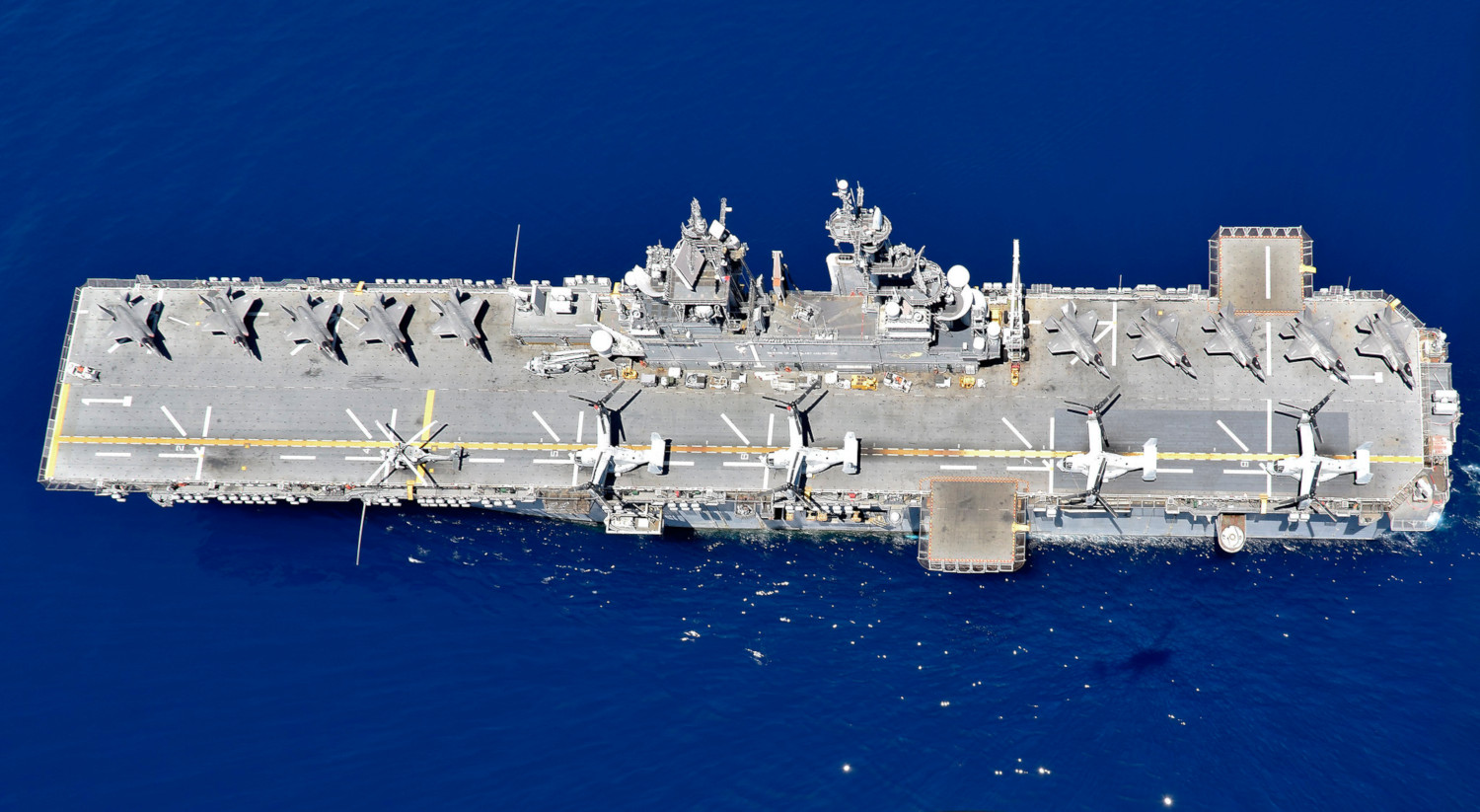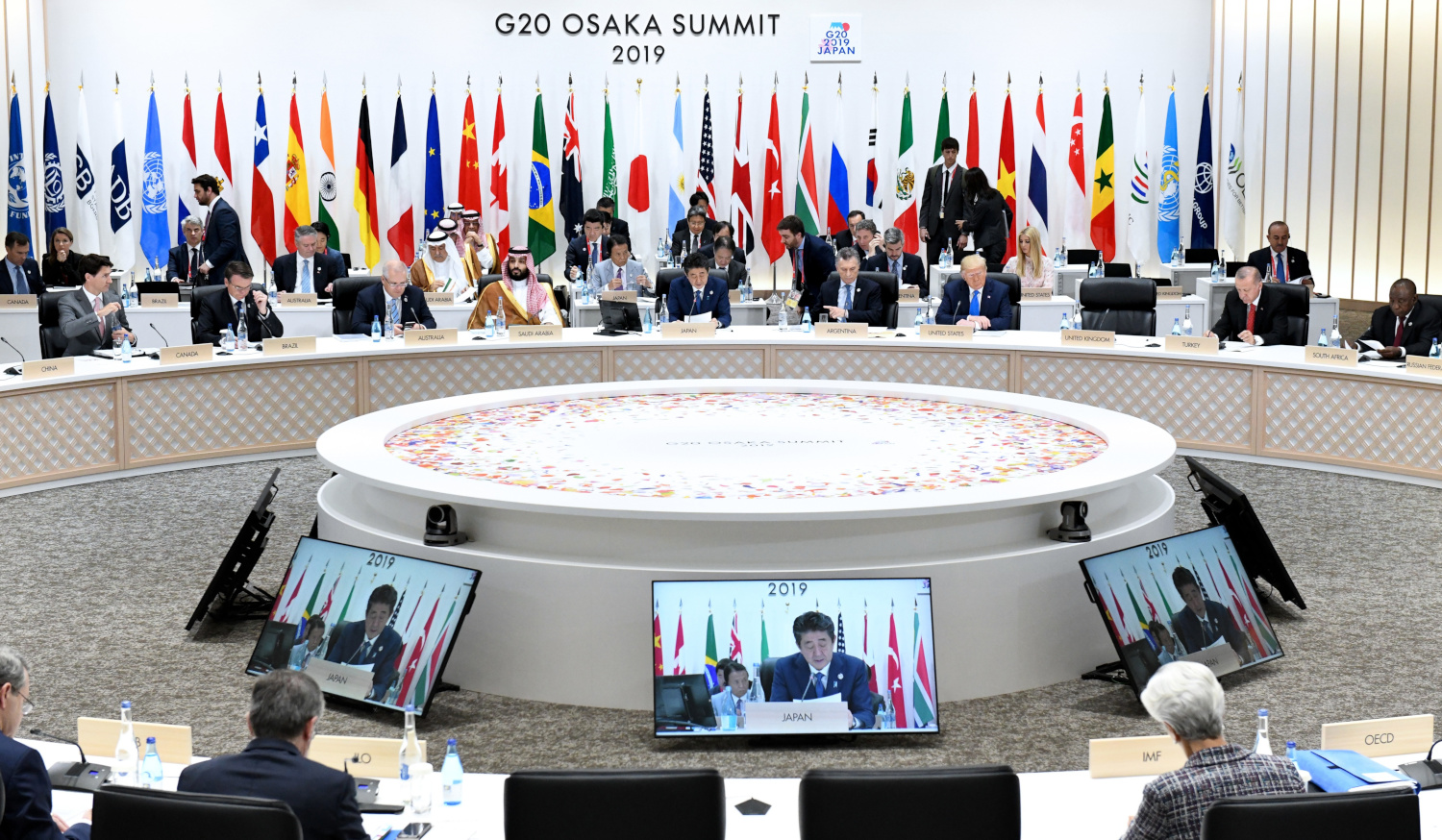THE WARSAW INSTITUTE REVIEW
Date: 4 November 2019 Author: Marta Kędzielska
American-Chinese relations in the trade war context
What are the causes of the current tension between Washington and Beijing? Why have the American President’s advisers opted for strengthening the relations with China for years? What does the return to the tianxia concept mean?
 US President Donald Trump shakes hands with Chinese President Xi Jinping during a meeting on the sidelines of the G-20 summit in Osaka, Japan, June 29, 2019. fot. Associated Press/East News
US President Donald Trump shakes hands with Chinese President Xi Jinping during a meeting on the sidelines of the G-20 summit in Osaka, Japan, June 29, 2019. fot. Associated Press/East NewsThe economic growth of the People’s Republic of China is surely the most important geopolitical event in the 21st century. It is no wild speculation to argue that an increasing number of scientists, experts and publicists realized the presence of a dragon, which had been previously treated as a lizard by the West. The phenomenon of the enormous progress of China in Graham Allison book “Destined for War: Can America and China Escape Thucydides’ Trap?”, which provides an analysis of geopolitical relations between the United States and China. He asked openly whether the conflict between these two countries is inevitable, as according to arguments, it even seems essential. The American researcher formulated the concept of Thucydides’ Trap through which he described the dynamics of competition for power between an old ruling power and a young candidate for domination. He describes it on the example of the Peloponnesian War and the rivalry between Athens and Sparta. However, such relationship occurs not only at the national level but also in other circles, such as families or companies. Allison writes: “the defining question about global order is whether China and the U.S. can escape the Thucydides’s Trap. Most contests that fit this pattern have ended badly. Over the past five hundred years, in sixteen cases, a major rising power has threatened to displace a ruling power. In twelve of those, the result was war[1].” However, Allison’s book does not aim to exacerbate the current situation but to set a path helping to avoid an armed conflict.
Most of the experts specialized in international relations with China follow the same reasoning. They are all aware that the military conflict between the United States and China would be definitely destructive for the whole world. Kevin Rudd, the former Prime Minister of Australia, who developed bilateral relations of both countries merits particular attention. He is one of the Western politicians with the best understanding of the Middle Kingdom (Zhongguo). Moreover, his ability to speak English and Mandarin significantly helped him to develop the American-Chinese diplomacy. In his famous lecture for TED, he excellently explained the Chinese mentality: “The Chinese to this day believe that the United States and the West do not accept the legitimacy of their political system because it’s so radically different from those of us who come from liberal democracies. And believe that the United States to this day is seeking to undermine their political system. China also believes that it is being contained by U.S. allies and by those with strategic partnership with the U.S. right around its periphery. And beyond that, the Chinese have this feeling in their heart of hearts and it their gut of guts that those of us in the collective West are just too damn arrogant”[2]. This means that in international relations, the Chinese do not want to be preached and looked down on or educated on the rules of liberal democracy functioning. They are characterized by the disapproval of the Western dictate, especially the USA. This is expressed in the saying: “What is Chinese is the essence, what is Western is a complement”. For the last five thousand years, the Chinese were ruling on their own and they do not need an older brother to hold their hand. The acceptance of the domestic policy of the Middle Kingdom is a condition of any international relations with this state. The Chinese do not want to interfere with the domestic affairs of their partners, and they expect to be treated in the same way.
NEWSLETTER
As the book of Graham Allison is a starting point for further discussions about the relations between the United States and China, it is necessary to pose a question, who woke up the American researcher from his geopolitical nap? Allison’s consideration of China was induced by his interview with the first Prime Minister and the founding father of Singapore, Lee Kuan Yew. This short, but great text was published as “Lee Kuan Yew: The Grand Master’s Insights on China, the US, and the World”. It is available in the Polish language version as well, even though in Poland, Lee Kuan Yew is almost completely unknown. The introduction to this paper written by Henry Kissinger begins with words: “I have had the privilege of meeting many world leaders over the past half century; none, however, has taught me more than Lee Kuan Yew, Singapore’s first premier and its guiding spirit ever since.”[3] Yew, being a Chinese educated in the Anglo-Saxon tradition at the University of Cambridge had a unique understanding of both civilizations: Chinese and American. This is the reason why he served as an adviser to all presidents of the United States, from Richard Nixon to Barack Obama, as well as many leaders of China. He was also a friend of Deng Xiaoping.
Lee Kuan Yew assessed the American-Chinese relations in the following way: “This is not a cold war. The Soviet Union competed with the USA for global supremacy. China acts only as China, in its own national interest. It is not interested in changing the world”. According to the Grand Master from the East, relations between the two countries will be marked by a struggle for influence but dimmed in the case of China as it needs the American market, technology and access to education in the USA for its own development. He also points out that there is no ideological conflict between the states as China enthusiastically embraced the free market and made use of globalization as well. Mutual relations are stabilized by trade dependence and a huge need for cooperation. We saw the evidence of this mutual relation during the G20 summit in Osaka when Donald Trump declared the end of the trade war and the end of the ban imposed on the cooperation with Huawei. Larry Kudlow, an economic adviser to the White House, immediately dampened the enthusiasm of the public opinion favoring this by commenting on Fox News that Huawei would not be granted an amnesty, the boycott of products of the Chinese tycoon would not be ceased, and the consent to sell American products is only temporary. However, the declaration of the President of the USA is valid and was not a gesture of compassion for all users of Huawei devices in order not to deprive them of access to Google tools. This is the effect of cold calculation of gains and losses of American companies for whom the loss of the Chinese clientele would result in an enormous fall of income. American and Chinese economies are, after all, very tightly interconnected.
 Amphibious assault ship USS Wasp (LHD 1) transits the waters of the South China Sea. Wasp, flagship of Wasp Amphibious Ready Group, is operating in the Indo-Pacific region to enhance interoperability with partners and serve as a lethal, ready-response force for any type of contingency, South China Sea, March 29, 2019. fot. Flickr.com/Naval Surface Warriors
Amphibious assault ship USS Wasp (LHD 1) transits the waters of the South China Sea. Wasp, flagship of Wasp Amphibious Ready Group, is operating in the Indo-Pacific region to enhance interoperability with partners and serve as a lethal, ready-response force for any type of contingency, South China Sea, March 29, 2019. fot. Flickr.com/Naval Surface Warriors‘Chimerica’
The current situation is the aftermath of changes in American-Chinese relations which happened in the ‘70s during the presidency of Richard Nixon. Henry Kissinger was the architect who led to the economic and partly political opening of the United States to China. This aimed not only to win influences in China against the Soviet Union but also to enhance the economic interests of the USA. The formation, called by some economists “Chimerica”, is the current result of years of enhancing the economic relations between both countries. After the temporary isolation of China which happened after the Tiananmen Square massacre, the Administration of Bill Clinton decided to separate the human rights issues from trade relations. Until the end of his presidency, the most favored treatment in trade was applied to Beijing. After 1992, China gained 282.6 billion dollars from foreign investments. Then, China unprecedentedly opened to the world and entered the process of globalization. As a result, in 1978-2012, the average annual growth in the Middle Kingdom amounted to 9.8 percent. American companies took advantage of the Chinese economy’s transformation. In the ‘90s, Americans relocated most of their factories to China to lower the costs of production. Until now, almost all of the biggest brands – such as Adidas, AT&T, Apple Computer, Avon, Coca Cola Foods, FedEx, General Motors, Gentek, Gerber Foods, Gillette Company, Johnson & Johnson, Starbucks Corporation, Whirlpool Corporation, Ralph Loren, to name a few – are producing goods in China. The list is endless. Many European corporations acted alike. This means that in order to achieve a lower cost of production, technologies, tools and know-how were exported to China. Workers were trained and hired there. The relocation of factories entails not only the relocation of manufacturing technologies but also their development. Workers in China developed new skills and are still enhancing them. It is not a secret that the Chinese use the method of copying and reproducing technological solutions, products, new technologies or even programs and applications. Western companies have given the Chinese capabilities and knowledge which were copied and further enhanced by them. Stealing has become a method of collecting new information and this is not kept in secret. In 2014, Director of the FBI James Comey admitted: “The amount of theft that’s going on is simply staggering. There’s only two types of big corporations in America. Those who have been hacked by the Chinese, or those who don’t yet know they’ve been hacked by the Chinese[4]”– he summed up. The results of the investigation carried out by the American CBS program also leave no doubt. The Chinese technological espionage cost American companies hundreds of billions of dollars. This is how the West created its greatest competitor by itself.
Only today, Americans have come to realize that they were lured by the desire to capture the huge Chinese market. Every administration of the USA since the ‘70s was convinced that the Chinese economic development equaled to the growth of the American GDP. Indeed, when it comes to the numbers, everything added up. Bilateral trade income in 1986 amounted to 8 billion dollars and within 30 years it rose to 578 billion. However, actions taken by the United States turned out to be very short-term orientated and focused on the interim profit. China has become a cheap exporter, the factory of the world and an extremely absorptive market which was a wonderland for big corporations. But nobody predicted that Chinese producers would use the possessed knowledge and skills to develop their own companies and solutions making the West entirely dependent on them. According to the author of the book “The China Challenge: Shaping the Choices of Rising Power”, American political scientist Thomas Christensen, “since the Chinese reform era began in 1978, no global actor has done more to assist China’s rise than the United States[5]”. American economists started to understand this problem. The assessment of Peter Navarro, one of the main advisers of President Donald Trump, expressed in his book “Death by China. Confronting the Dragon – A Global Call to Action” is especially crucial. We can observe the influence of this publication in the subsequent stages of the current trade war. “Not coincidentally, as China has systematically hollowed out American manufacturing base, its economy has grown at the astonishing rate of 10% annually. In contrast, over the past decade, the U.S. economy has expanded at a rate of only 2,4%. Note that this paltry 2,4% growth rate during the 2000s if fully 25% below American’s historical growth rate of 3,2% between 1946 and 1999. (…) That 0,8% differences equates to a failure to create almost million jobs a year and, cumulatively, over 10 million jobs over the last decade[6]”.
Among the American administration, especially experts and advisers on relations with China, such as Henry Kissinger, Henry Paulson, or Michael Pillsbury, there was a belief that economic liberalization and opening to global markets would go in par with political liberalization of China. This was the biggest mistake in the assessment of the Chinese civilization – all mentioned specialists admit. The support for the authorities ruling in the Middle Kingdom reaches 80 percent which is higher than in any western country. The Chinese trust their leaders and are driven by a common target which is the development of the state and enrichment of the society. They do not think that western political solutions are better in any way or more proper for China. Lee Kuan Yew understood this matter properly: “China is not going to become a liberal democracy; if it did, it would collapse. Of that, I am quite sure, and the Chinese intelligentsia also understands that. If you believe that there is going to be a revolution of some sort in China for democracy, you are wrong. Where are the students of Tiananmen now? They are irrelevant. The Chinese people want a revived China[7]”.
 G20 leaders attend session 3 at a G20 summit meeting in Osaka, June 29, 2019. fot. Associated Press/East News
G20 leaders attend session 3 at a G20 summit meeting in Osaka, June 29, 2019. fot. Associated Press/East NewsThe center of the world
Traditionally, there are five directions in China: north, south, east, West, and… center. The center is China, which is “everything under the Heavens”. In contemporary China, Confucian traditions are clearly reviving. Many thinkers come back to the traditional system and concept tianxia – ancient belief implanted in the Chinese mentality that they constitute the center of the world and all foreign grounds are barbaric and crude. China is the only and true civilization and their cultural superiority is unquestionable. No other country can equal China. Chinese intellectuals, for example, philosopher Zhao Dingyang from the Chinese Academy of Social Sciences, are more and more frequently using this concept. For hundreds of years, the Middle Kingdom has functioned in the tianxia system. This system assumed the existence of a rigid center – China, and the existence of other subordinate elements located around China which used to pay the tribute for care and good relations. The Middle Kingdom had cultural supremacy over neighboring countries, however, it was not focused on conquering them, but on gentle influencing through values, morality and order. This is well explained by Dr Jacek Bartosiak in his work “Pacyfik i Eurazja. O wojnie”(Pacific and Euroasia. About war), stating “there was no Westphalian system known by the West since the Thirty Years’ War in the 17th century providing for the sovereignty of states functioning in power relations, stabilizing each other and looking for alliances to balance the system[8]”. China lost its dominating position in the 19th century, eventually after the First Opium War in 1839-1842. In the whole history of China, it is a very short period.
Support Us
If content prepared by Warsaw Institute team is useful for you, please support our actions. Donations from private persons are necessary for the continuation of our mission.
The Chinese believe that they have the right to dictate their will to their neighbors comes from the tianxia system. Analyses of the current relations between the United States and China point to two hot spots. These are the situation in the Korean Peninsula with the unpredictable policy of Kim Jong-un (China does not want the unification of Korea for many strategic reasons) and open disputes in the South China Sea. Freedom of navigation, especially in the most frequently used world communication routes: in the South China Sea and the East China Sea, protected by the US navy, is one of the main rules of the current order, sanctioned by the United States. However, China is trying to force the US Navy’s ships out of these waters. According to Bartosiak, as a response to similar actions, Americans are trying to develop and implement a concept of the air-naval war which aims to restore the American control over the communication routes leading to the allies in the region and assure freedom of navigation. However, Beijing is frequently mentioning the establishment of the two-hundred-miles Exclusive Economic Zone (EEZ) in the South China Sea. It would result from the need to develop the maritime power of China and the necessity to make investments in the world to protect their economic and strategic interests, which in practice would prevent the US Navy from sailing in the EEZ territory. The most popular effect of this conflict known to the public is the construction of artificial islands by China on which the airport and harbor infrastructure is being developed to increase their power projection in the region.
In order to stop the expansion of China in the South China Sea region, Americans are trying to enhance the alliance with Vietnam, Malaysia, and the Philippines. However, the Philippines is the only country that has officially signed the alliance with the USA. It has lasted since 1961 but was only confirmed on January 12, 2016, by the Supreme Court in Manila. The pact allows the Americans to access the infrastructure on the islands while the USA’s strategy provides for the enhancement of allied airborne capabilities. The East China Sea has also become the arena for the American-Chinese increasing strategic competition where Japan as the American ally, is playing an important role. “China, Japan, and the USA as well treat this water area as a place of a potential marine-air confrontation which is visible in maneuvers, exercises and demonstrations of power so frequent after 2012. To prove that, on December 25, 2015, the cabinet in Tokyo accepted the increase in the 2016 defense budget[9]”.
The situation in the South China Sea has its origin conveyed directly in the geostrategic ambitions of the Middle Kingdom. Xi Jinping is aware that the establishment of a maritime Silk Road is fully dependent on having control over these waters. The Chinese are not aiming at an armed conflict as their strategy for years entailed the avoidance of war. However, the control over sea routes conditions the development of trade which remains the highest priority for China. According to Allison: “As long as developments in the South China Sea are generally moving in China’s favor, it appears unlikely to use military force. But if trends in the correlation of forces should shift against it, particularly at a moment of domestic political instability, China could initiate a limited military conflict[10]”.
There is no sense in guessing what may happen. The situation is dynamic. The key matter is to understand the scale and significance of the leap that China has made since the times of Mao to the governance of Xi Jinping and the awareness of the Chinese, global political, economic, cultural, and military impact. This is suggested by the combination of a 1350-million-people (that is 1.35 billion persons) population of China with a great pace of economic development, which led to the establishment of a superpower within less than 30 years. Everyone who visited at least one Chinese city understands it. The number of citizens and the scale of development amazes and overwhelms at the same time. The ambitious plan of Xi Jinping announced in October 2017 during the 19th meeting of CPC provides for the formation of a “moderate welfare society” until 2021 and the creation of a modern, innovative state until 2035. Xi Jinping’s plan is prepared in detail and looks to the future as the Chinese, in contrast to the Europeans, create plans for generations. Until 2049, China is to become a modern power with a strong economy as well as services, industry and technology. Xi Jinping also talked about the influence of Chinese culture on the rest of the world. What would this influence be like? Can the world operate in the bipolar American-Chinese system? It is difficult to define yet. But for sure, China is the new, ambitious power divested of the western malaise which wants to struggle for its position in the world. Therefore, changes are inevitable and will be succeeding before our eyes. The new global order is being established right now.
[1] Graham Allison, Destined for War: Can America and China Escape Thucydides’s Trap?, Houghton Mifflin Harcourt, 2017, p. 17.
[2] https://www.youtube.com/watch?v=8XQ1onjXJK0
[3] Graham Allison, Robert D. Blackwill and Ali Wyne, Lee Kuan Yew: The Grand Master’s Insights on China, the United States, and the World, MIT Press, 2012, p. 7.
[4] as in Graham Allison, Destined for War: Can America and China Escape Thucydides’s Trap?, Houghton Mifflin Harcourt, 2017, p. 17
[5] Thomas Christensen, The China Challenge. Shaping the Choices of Rising Power, W.W.Norton&Co, New York-London, 2015, Prologue.
[6] Peter Navarro, Death by China. Confronting the Dragon – A Global Call to Action, Pearson Education, New Jersey, 2010, pp. 52, 53.
[7] Graham Allison, Robert D. Blackwill and Ali Wyne, Lee Kuan Yew: The Grand Master’s Insights on China, the United States, and the World, MIT Press, 2012, p. 14.
[8] Jacek Bartosiak, Pacyfik i Eurazja. O wojnie, Wydawnictwo Jacek Bartosiak, Warsaw, 2016, p. 308.
[9] Jacek Bartosiak, Pacyfik i Eurazja. O wojnie, Wydawnictwo Jacek Bartosiak, Warsaw, 2016, p. 573.
[10] Graham Allison, Destined for War: Can America and China Escape Thucydides’s Trap?, Houghton Mifflin Harcourt, 2017, p. 153.
All texts published by the Warsaw Institute Foundation may be disseminated on the condition that their origin is credited. Images may not be used without permission.














